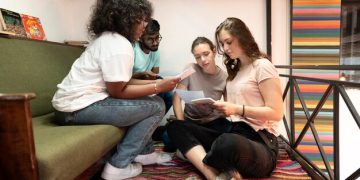Bridging the Digital Divide: $300M Program’s Impact on Gen Z Internet Access by 2025

A new federal initiative allocating $300 million for internet access seeks to alleviate the digital divide, aiming to provide equitable connectivity for Gen Z students by 2025 across the United States. Its success hinges on effective implementation and targeted outreach to vulnerable communities.
The persistent challenge of unequal internet access, widely known as the digital divide, continues to shape educational and socioeconomic outcomes across the United States. A recent federal program, allocating a substantial $300 million to enhance internet access, aims to specifically target disadvantaged communities, raising a critical question: will this new federal program providing $300 million in internet access bridge the gap for Gen Z students by 2025?
Understanding the Digital Divide and its Impact on Gen Z
The digital divide refers to the gap between those who have ready access to computers and the internet, and those who do not. This disparity is not merely about having a device; it encompasses consistent, reliable, and affordable broadband internet access, along with the digital literacy to effectively utilize these tools. For Gen Z students, a generation born into a world increasingly reliant on digital tools, this gap has profound implications for their educational trajectories and future opportunities.
The impact extends far beyond homework assignments. It affects skill development, access to online learning resources, career preparation, and even social connection. Students without adequate internet often face significant hurdles, falling behind peers who enjoy seamless connectivity.
Socioeconomic and Geographic Factors
The digital divide disproportionately affects specific demographic and geographic groups. Urban areas may suffer from affordability issues despite infrastructure presence, while rural areas often lack the necessary infrastructure altogether. Furthermore, lower-income households and minority communities frequently experience the most acute forms of this divide.
- Income Disparity: Families with limited financial resources often cannot afford high-speed internet plans or multiple devices for household members.
- Rural vs. Urban: Remote areas often lack the broadband infrastructure that is commonplace in metropolitan centers, leading to slower speeds or no service at all.
- Ethnic and Racial Minorities: Historically marginalized groups frequently face compounding disadvantages, including limited access to both affordable internet and necessary digital skills training.
These factors contribute to a complex web of challenges that impede equitable access. Understanding these underlying causes is crucial for designing effective interventions, ensuring that solutions like the new federal program are truly impactful and reach those most in need. Without addressing these foundational issues, any program, regardless of its funding, risks falling short of its ambitious goals.
The severity of the digital divide, particularly for Gen Z, underscores the urgency of initiatives like the new federal program. It highlights how internet access has transformed from a luxury into a fundamental necessity for participation in modern society. Closing this gap is not just an educational imperative but a societal one, determining the future readiness and competitiveness of an entire generation.
Overview of the New Federal Program: What $300 Million Means
The recently announced federal program, a significant investment of $300 million, represents a crucial step in the ongoing effort to combat the digital divide. This funding is specifically earmarked for initiatives aimed at expanding internet access, with a particular focus on bridging the connectivity gap for Gen Z students. Understanding the structure and intended use of these funds elucidates the program’s potential scope and impact.
The allocation is likely to support a variety of measures, ranging from infrastructure development in underserved areas to providing direct subsidies for internet service and devices to eligible households. Such a multi-pronged approach is essential, recognizing that the digital divide is not a singular problem but a collection of interconnected challenges stemming from infrastructure, affordability, and digital literacy.
Key Objectives and Allocation Strategies
While specific details of the program’s allocation may vary, federal initiatives of this nature typically prioritize several key objectives. The $300 million is intended to foster an environment where every student, regardless of their socioeconomic background or geographic location, has the tools necessary to succeed in a digitally-driven educational landscape.
- Broadband Infrastructure Expansion: A significant portion of the funds may be directed towards building out or upgrading broadband infrastructure in rural and low-income urban areas, addressing the fundamental issue of availability.
- Affordable Internet Subsidies: Programs could provide direct financial assistance to low-income families, making high-speed internet services more affordable and accessible.
- Device Distribution: Initiatives might include the distribution of laptops, tablets, or other necessary devices to students and households that currently lack them, ensuring they have the hardware to connect.
- Digital Literacy and Training: Some funds will likely be allocated to educational programs that teach essential digital skills, helping individuals effectively use the internet for learning and daily life.
The success of the program will largely depend on its ability to effectively coordinate efforts across various stakeholders, including federal agencies, state and local governments, internet service providers, and community organizations. Seamless collaboration is critical to ensure that the funds are deployed efficiently and reach the intended beneficiaries without undue bureaucratic hurdles.
This $300 million investment signifies a strong commitment from the federal government to address a pressing societal issue. Its design aims to tackle both the supply side (infrastructure) and demand side (affordability and skills) of internet access, offering a comprehensive approach to an intricate problem. The potential for a transformative impact on Gen Z students by 2025 is considerable, provided the execution aligns with these ambitious objectives.
Challenges and Hurdles for Implementation by 2025
While the $300 million federal program offers a beacon of hope for bridging the digital divide, its successful implementation by the ambitious deadline of 2025 formidable challenges. The path from funding allocation to widespread, equitable internet access is fraught with logistical, technical, and socioeconomic hurdles that demand careful navigation and robust solutions.
One primary challenge lies in the sheer scale of the problem. Despite significant investment, the digital divide is deeply entrenched, affecting millions of households across diverse geographic and demographic landscapes. Reaching every underserved Gen Z student within a tight timeframe requires an unprecedented level of coordination and adaptability.
Infrastructure Development and Deployment
Building or upgrading broadband infrastructure, especially in remote or difficult-to-reach areas, is a complex and time-consuming endeavor. The process involves securing rights-of-way, extensive trenching or cabling, and navigating diverse terrains, all of which can lead to significant delays and cost overruns.
- Geographic Barriers: Laying fiber optic cables across mountains, dense forests, or vast rural expanses presents considerable engineering and logistical challenges.
- Permitting and Bureaucracy: Obtaining necessary permits from local, state, and federal entities can be a slow and arduous process, often creating bottlenecks in deployment.
- Skilled Labor Shortages: There is an ongoing demand for skilled technicians and construction workers necessary for installing and maintaining broadband networks, potentially limiting the pace of expansion.
Beyond infrastructure, addressing affordability remains a significant hurdle. Even with subsidies, many families may struggle to meet the remaining costs or may not be aware of available assistance programs. Ensuring that these subsidies effectively reach and sustain connectivity for the neediest households requires robust outreach and streamlined application processes.
Furthermore, digital literacy is not a given. Providing internet access without simultaneously offering education on how to use it safely and effectively can limit its benefit. Programs must account for varying levels of digital proficiency among students and their families, offering targeted training where necessary.
Meeting the 2025 deadline will require exceptionally efficient project management, flexible policy adjustments, and continuous monitoring of progress. Overcoming these challenges will be key to determining whether the $300 million investment truly translates into a bridged digital divide for Gen Z students across the nation.

Potential Success Factors and Best Practices
The ambition of the new federal program to bridge the digital divide for Gen Z students by 2025, while challenging, is certainly achievable with the right strategies and best practices. Identifying and leveraging key success factors can significantly enhance the program’s effectiveness and ensure its substantial financial investment yields tangible results. This involves learning from past initiatives and adapting to the unique needs of diverse communities.
One critical success factor is a truly collaborative approach. No single entity can solve the digital divide alone. Success relies on seamless partnerships between federal, state, and local governments, internet service providers (ISPs), non-profit organizations, community leaders, and educational institutions. Each plays a vital role in identifying needs, deploying solutions, and ensuring sustainability.
Targeted Outreach and Community Engagement
Effective outreach is paramount to ensure that the intended beneficiaries are aware of and can access the program’s benefits. This goes beyond traditional advertising; it requires direct community engagement, building trust, and understanding specific local barriers.
- Local Partnerships: Collaborating with established community centers, schools, and faith-based organizations can facilitate outreach to hard-to-reach populations.
- Multilingual Information: Providing program information in multiple languages ensures accessibility for diverse linguistic groups, reducing communication barriers.
- Simplified Application Processes: Streamlining eligibility verification and application procedures can reduce intimidation and administrative burden for prospective beneficiaries.
Another crucial element is flexibility in solution delivery. Given the varied nature of connectivity challenges—from infrastructure gaps in rural areas to affordability issues in urban centers—a one-size-fits-all approach is unlikely to succeed. The program should enable localized solutions, whether that means subsidizing satellite internet in very remote areas or focusing on fiber-to-the-home in others.
Furthermore, incorporating digital literacy and technical support as integral components of the program is essential. Providing devices and internet access is only part of the solution; empowering users with the skills to confidently and safely navigate the online world, and offering accessible technical assistance when problems arise, ensures sustained engagement and benefit.
Ultimately, the program’s success will hinge on its ability to be agile, responsive, and deeply connected to the communities it serves. By focusing on collaboration, customized solutions, comprehensive support, and clear communication, the $300 million investment has a strong potential to make a transformative difference in bridging the digital divide for Gen Z students by the 2025 target.
Measuring Success: Metrics and Indicators by 2025
To definitively assess whether the new federal program providing $300 million in internet access successfully bridges the digital divide for Gen Z students by 2025, a robust framework for measuring success is indispensable. This framework must encompass both quantitative metrics and qualitative indicators, providing a comprehensive view of the program’s impact beyond mere spending figures. Clear benchmarks and regular evaluations will be critical for accountability and for informing future policy decisions.
The primary goal is to close the gap in internet access, but “access” itself needs to be carefully defined. It’s not just about having some form of connection, but rather access to reliable, high-speed, and affordable broadband that meets the demands of modern education and daily life. Therefore, metrics should reflect these nuances.
Key Performance Indicators (KPIs)
Several key performance indicators can be established to track the program’s progress towards its 2025 objective. These KPIs should target different facets of the digital divide, from infrastructure to adoption rates.
- Broadband Penetration Rate: Measure the percentage of households with Gen Z students that have access to high-speed broadband (e.g., 100/20 Mbps or higher) within service areas.
- Adoption Rate Among Low-Income Households: Track the number and percentage of eligible low-income families who subscribe to and consistently use internet services as a direct result of program subsidies.
- Device Ownership: Monitor the increase in the number of Gen Z students reporting access to a dedicated learning device (laptop, tablet) at home.
- Digital Skills Proficiency: Assess improvements in digital literacy through surveys or standardized assessments among participating students, focusing on essential skills for online learning.
Beyond these quantitative measures, qualitative indicators are equally important. These might include student testimonials, teacher feedback on improvements in remote learning engagement, and reports from community organizations on the broader socioeconomic impacts of enhanced connectivity. Such anecdotal evidence, while not statistical, provides valuable insight into the human dimension of the program’s success.
Moreover, monitoring for unintended consequences is crucial. For example, ensuring that increased internet access does not inadvertently exacerbate existing inequalities, or that cybersecurity education is integrated to protect students online. The ability to collect, analyze, and report on these metrics transparently will be a key determinant of whether the $300 million truly leads to a bridged digital divide for Gen Z, making progress tangible and verifiable by the 2025 deadline.

Long-Term Sustainability Beyond 2025
While the immediate focus of the $300 million federal program is to bridge the digital divide for Gen Z students by 2025, a critical aspect of its true success lies in its long-term sustainability. Achieving equitable internet access and ensuring its permanence beyond the program’s initial funding window requires a forward-looking strategy that addresses not just the present need but also future technological advancements and evolving societal demands. Without a sustainable model, the progress made by 2025 risks being ephemeral.
Sustainability often hinges on fostering self-reliance within communities and creating perpetual funding mechanisms rather than relying solely on one-off federal injections. This involves empowering local leaders, building robust digital infrastructure that can be easily maintained and upgraded, and promoting economic models that make internet access inherently affordable for all.
Strategies for Lasting Impact
To ensure the benefits endure beyond the initial program timeline, several long-term strategies should be considered and integrated into the overall framework. These strategies aim to institutionalize equitable access and continually adapt to the digital landscape.
- Public-Private Partnerships: Encouraging sustained collaboration between government and internet service providers to invest in infrastructure and offer affordable plans as part of their standard business models, rather than solely through subsidies.
- Community Broadband Initiatives: Supporting and funding local community-owned networks or municipal broadband projects, which can provide more affordable and responsive services tailored to local needs.
- Digital Literacy Integration: Embedding digital literacy education into school curricula and adult learning programs, ensuring that future generations and adults are equipped with the skills to navigate the digital world independently.
- Policy Advocacy and Regulatory Reform: Continuing to advocate for policies that prioritize universal broadband access, regulate pricing to ensure affordability, and encourage competition among ISPs.
Financial sustainability also involves exploring diverse funding streams. This could include state-level allocations, philanthropic contributions, and innovative funding models such as “dig once” policies, which require broadband conduit installation during road construction, reducing future costs. Furthermore, the program should foster an environment where digital inclusion is seen as an ongoing societal responsibility, not just a temporary project.
Ultimately, the long-term success of the $300 million program will be defined by its legacy beyond 2025. Will it fade, or will it lay a permanent foundation for a digitally equitable future for all Gen Z students and succeeding generations? By focusing on sustainable infrastructure, lasting literacy, and perpetual partnerships, the program can ensure its impact is not merely a short-term fix but a lasting transformation.
The Role of Gen Z in Shaping Their Digital Future
While federal programs and policy initiatives are critical in providing the infrastructure and financial support for internet access, the role of Gen Z itself in shaping their digital future cannot be overstated. This generation, often called “digital natives,” possesses a unique understanding of technology and its potential. Their active participation, both as beneficiaries and as advocates, is fundamental to truly bridging the digital divide and ensuring that solutions are relevant and effective.
Gen Z students are not passive recipients of technology; they are active users, creators, and innovators. Their experiences navigating both the connected and disconnected worlds provide invaluable insights into the practical challenges and opportunities of digital inclusion. This firsthand perspective should inform how resources are allocated and how programs are designed to meet real-world needs.
Advocacy and Innovation from Within
Gen Z possesses a powerful voice and a strong sense of social justice. Many students are already engaged in advocating for equitable access, bringing attention to the disparities they observe in their own communities and educational environments.
- Student-Led Initiatives: Young people are organizing and participating in campaigns to raise awareness about the digital divide, collecting data, and proposing solutions to local authorities.
- Peer-to-Peer Learning: Tech-savvy Gen Z students can play a crucial role in mentoring their peers and older generations, helping to build digital literacy skills within their communities.
- Feedback Loops: Establishing mechanisms for Gen Z students to provide direct feedback on the effectiveness of new programs and technologies ensures that solutions are genuinely user-centric and beneficial.
Furthermore, Gen Z’s innovative spirit can lead to unexpected solutions. Their comfort with digital tools and platforms makes them adept at identifying creative ways to leverage technology for learning, collaboration, and problem-solving, even within resource constraints. Empowering them to contribute ideas and lead projects can foster a sense of ownership and drive more sustainable change.
The program’s success by 2025 will be significantly amplified if it actively involves Gen Z in its design and implementation. This means listening to their needs, incorporating their perspectives, and supporting their efforts to advocate for themselves and their communities. By recognizing Gen Z not just as the target of intervention but as partners in progress, the federal program can tap into a powerful force for enduring digital equity, ensuring that the future they inherit is one of boundless connectivity and opportunity.
| Key Point | Brief Description |
|---|---|
| 📶 Program Funding | A new federal program allocates $300 million to boost internet access for Gen Z students by 2025. |
| 🚧 Implementation Challenges | Hurdles include infrastructure deployment, affordability, and digital literacy training within a tight deadline. |
| 📈 Success Metrics | Success will be measured by broadband penetration, adoption rates, device ownership, and improved digital skills. |
| 🌱 Long-term Impact | Sustainability depends on public-private partnerships, community initiatives, and ongoing policy advocacy beyond 2025. |
Frequently Asked Questions About the Digital Divide Program
The program aims to significantly reduce the digital divide by enhancing internet access, specifically targeting Gen Z students in underserved communities across the United States. Its goal is to ensure equitable connectivity for learning and future opportunities by 2025.
The funds are expected to support broadband infrastructure development in rural and low-income areas, provide subsidies for affordable internet services, facilitate device distribution to students, and fund digital literacy training programs to ensure effective internet usage.
Potential challenges include the complexity of infrastructure deployment in diverse terrains, bureaucratic hurdles in securing permits, ensuring affordability for all eligible families, and developing comprehensive digital literacy programs that meet varied skill levels.
Success will be measured through key performance indicators such as increased broadband penetration rates, a higher adoption rate of internet services among low-income households, improved device ownership among students, and quantifiable enhancements in digital skills proficiency.
Long-term sustainability depends on fostering public-private partnerships, supporting community-owned networks, integrating digital literacy into education, and advocating for policies that ensure universal and affordable broadband access, creating a lasting impact beyond the initial funding period.
Conclusion
The allocation of $300 million towards bridging the digital divide for Gen Z students by 2025 represents a significant and timely federal commitment to equitable internet access. While the challenges of infrastructure, affordability, and digital literacy are substantial, the program’s potential for transformative impact is equally immense. Success hinges on a multi-faceted approach, combining robust funding with strategic implementation, flexible solutions, and a keen focus on sustainability beyond the initial timeline. By leveraging best practices, fostering genuine collaboration across all levels of government and community, and actively involving Gen Z in the process, this initiative can lay a crucial foundation for a future where every student has the digital tools necessary to thrive. The journey to 2025 will be a testament to collective resolve, aiming to ensure that connectivity is a right, not a privilege, for the next generation.





